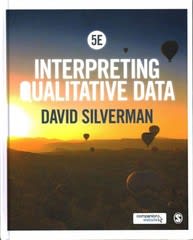Question
An annotated bibliography, consisting of FIVE scholarly sources related to the group's topic. My Topic: How teacher expectations influence student performance My References: 1. DarlingHammond,
An annotated bibliography, consisting ofFIVE scholarly sourcesrelated to the group's topic.
My Topic: How teacher expectations influence student performance
My References:
1. DarlingHammond, L., Flook, L., Cook-Harvey, C. M., Barron, B., & Osher, D. (2019). Implications for educational practice of the science of learning and development. Applied Developmental Science, 24(2), 97-140. https://doi.org/10.1080/10888691.2018.1537791
2. DeCuir-Gunby, J. T., & Bindra, V. G. (2022). How does teacher bias influence students?: An introduction to the special issue on teachers' implicit attitudes, instructional practices, and student outcomes. Learning and Instruction, 78, 101523. https://doi.org/10.1016/j.learninstruc.2021.101523
3. McKown, C., & Weinstein, R. S. (2008). Teacher expectations, classroom context, and the achievement gap. Journal of School Psychology, 46(3), 235-261. https://doi.org/10.1016/j.jsp.2007.05.001
4. Mok, M. M. C., & Moore, P. J. (2019). Teachers & self-efficacy. Educational Psychology, 39(1), 1-3. https://doi.org/10.1080/01443410.2019.1567070
5. Szumski, G., & Karwowski, M. (2019). Exploring the Pygmalion effect: The role of teacher expectations, academic self-concept, and class context in students' math achievement. Contemporary Educational Psychology, 59, 101787. https://doi.org/10.1016/j.cedpsych.2019.101787
Specifications:
- Analyze at leastFIVE scholarly sourcesrelated to group's topic (listed above)
- All sources should be SCHOLARLY and RELEVANT to research topic and question (at least at this point in time, though your direction might change)
- Articles should be published within the last 10 years (with a few exceptions)
- At least TWOshould be PEER-REVIEWED, PRIMARY RESEARCH (i.e., the researchers designed and carried out a research study and collected their own data); the othersdo not have to be primary research, but should still come from scholarly sources
- Include full citation (properly formatted according to APA) and annotation paragraph for each entry.
------------------------------------------------------------------------------------------------------------------------------------------------------------------------------------
Elements of an Annotated Bibliography:
Each annotation should include the elements listed below. The annotations should be in own words (do not quote extensively from the text) and written in paragraph form (rather than bullet-points).
- CITATIONwritten in the appropriate style (APA, will also accept MLA)
- ANNOTATION(~200-300 word paragraph)
- Summarize / Describethe content (each bullet can be written in approximately 1 sentence)
- Type & purpose of the work (research study, historical document, opinion piece, etc.)
- Intended audience
- Thesis, hypothesis(es), or research question(s)
- Methods (if provided or implied)
- Research: sample, setting, data collection and analysis procedures (statistical tests if quantitative)
- Non-research piece: theoretical framework(s)
- Key findings/conclusions
- Evaluate/Critiquethe work, considering the following:
- Methods; Analysis; Use of evidence; Conclusions; Limitations; Support for generalizations
- Effectiveness
- How recently published?
- Author's qualifications and any biases he/she may have
- Identify implicationsto other works in the field and to own research. Why is this research significant? How is it useful for you?
- Note additional info- such as keywords, key works cited, unique features of the article, additional reactions/comments you have. Humanities researchers might also with to note if this is a (potential) primary or secondary source.
Example (note: per APA the following *should* be double-spaced, but I wanted to keep on one page*)
Appleby, D. C., & Appleby, K. M. (2006). Kisses of death in the graduate school application process.Teaching of Psychology,33(1), 19-24.https://doi.org/10.1207/s15328023top3301_5Links to an external site.
The authors, researchers in the fields of psychology and sport science, surveyed psychology graduate admissions committee chairs to determine characteristics and practices of graduate school applicants that decrease chances for acceptance in order to offer strategies to enable applicants to avoid "kisses of death [KODs]" when applying to psychology graduate programs. KODs were defined as types of information that caused graduate admissions committees to reject otherwise strong applicants. Qualitative analysis of 156 responses to an open-ended prompt yielded five KODs: (a) damaging personal statements, (b) harmful letters of recommendation, (c) lack of program information, (d) poor writing skills, and (e) misfired attempts to impress. The authors also include a table offering tips for avoiding the KODs intended for use as a handout for students. The response rate was relatively low, with only 19% of contacts responding. Additionally, only psychology graduate admissions committee chairs were included, so generalizability to other fields may be limited, and more current research may yield different trends.
Step by Step Solution
There are 3 Steps involved in it
Step: 1

Get Instant Access to Expert-Tailored Solutions
See step-by-step solutions with expert insights and AI powered tools for academic success
Step: 2

Step: 3

Ace Your Homework with AI
Get the answers you need in no time with our AI-driven, step-by-step assistance
Get Started


